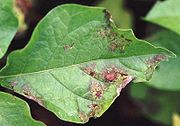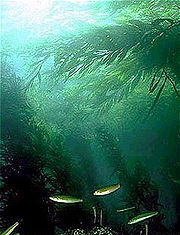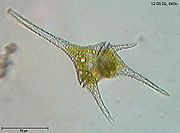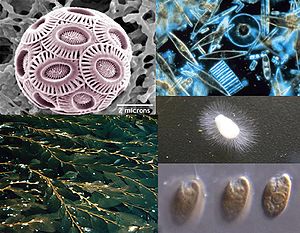Chromalveolata
Chromalveolata is a eukaryote supergroup first proposed by Thomas Cavalier-Smith as a refinement of his kingdom Chromista, which was first proposed in 1981. It was proposed to represent the result of a single secondary endosymbiosis of a line descending from a bikont with a red alga that became the progenitor of chlorophyll-c containing plastids. As of 2006, it was often regarded as one of six major clades of eukaryotes, although it is hotly debated and does not appear to be monophyletic as originally proposed. Specifically, recent expressed sequence tag analysis has suggested that haptophyta and cryptophyta are less closely related, while Rhizaria groups in a clade dubbed the "SAR" super assemblage with Alveolata and stramenopiles.Chromalveolates are not given any formal taxonomical classification, but may be considered a “kingdom”. They include the major groups:
⇒ Heterokontophyta
⇒ Alveolata
⇒ Dinoflagellata
⇒ Apicomplexa
⇒ Ciliophora
⇒ Haptophyta
⇒ Cryptophyta
Though several groups, such as the ciliates and the water molds, have lost the ability to photosynthesize, most are autotrophic. All photosynthetic chromalveolates use chlorophylls a and c, and many use accessory pigments.
Contents
⇒ Evolutionary relationship
⇒ Morphology
⇒ Ecological role
⇒ References
Evolutionary relationship
Chromalveolata is part of the bikonts, which also comprise the Archaeplastida, the Rhizaria, the Excavata, and some smaller, unresolved groups such as the Apusozoa and the Centrohelida. As bikonts, they all descend from a heterotrophic eukaryote with two flagella. It is also thought that the Chromalveolata share a closer relationship with the Archaeplastida than with the other groups, and some have proposed a clade called Corticata for this grouping.
Historically, many chromalveolates were considered plants, with their cell walls, photosynthetic ability, and in some cases their morphological resemblance to the Embryophyta. However, when the five-kingdom system took prevalence over the animal-plant dichotomy, most chromalveolates were put into the kingdom Protista, with the water molds and slime nets put into the kingdom Fungi, and the brown algae staying in the plant kingdom. Later, Chromalveolata was proposed as a monophyletic group, but the monophyly of this group is not yet established.
Other groups which may be included within, or related to, Chromalveolates, are:
⇒ Telonemia
 |
|
A potato plant infected with Phytophthora infestans. |
|
 |
|
A Californian kelp forest. |
|
Morphology
Chromalveolates, unlike other groups with multicellular representatives, do not have very many common morphological characteristics. Each major subgroup has certain unique features, including the alveoli of the Alveolata, the haptonema of the Haptophyta, the ejectisome of the Crytophyta, and the two different flagella of the Heterokontophyta. However, none of these features are present in all of the groups. The only common chromalveolate features are these:
⇒ The shared origin of chloroplasts, as mentioned above
⇒ Presence of cellulose in most cell walls
Since this is such a diverse group, it is difficult to summarize shared chromalveolate characteristics.
Ecological role
Many chromalveolates affect our ecosystem in enormous ways. Some of these organisms can be very harmful.
Dinoflagellates produce red tides which can devastate fish populations and intoxicate oyster harvests. Apicomplexans are some of the most successful specific parasites to animals. Water molds cause several plant diseases. In fact, it was a water mold, Phytophthora infestans, that caused the Irish potato famine.
However, many chromalveolates are vital members of our ecosystem. Diatoms are one of the major photosynthetic producers, and produce much of the oxygen we breathe, and also take in much of the carbon dioxide that is thought to be a cause of global warming. Brown algae, most specifically kelps, create underwater "forest" habitats for many marine creatures, and provide a large portion of the diet of coastal communities.
Chromalveolates also provide many products that we use. The algin in brown algae is used a food thickener, most famously in ice cream. The siliceous shells of diatoms have many uses, such as in reflective paint, in toothpaste, or as a filter, in what is known as diatomaceous earth.
References
| - | Burki F, Shalchian-Tabrizi K, Minge M, Skjæveland Å, Nikolaev SI, et al. (2007). "Phylogenomics Reshuffles the Eukaryotic Supergroups". PLoS ONE 2 (8: e790): e790. |
| - | Fabien Burki, Kamran Shalchian-Tabrizi, Marianne Minge, Åsmund Skjæveland, Sergey I. Nikolaev, Kjetill S. Jakobsen, Jan Pawlowski (2007). "Phylogenomics Reshuffles the Eukaryotic Supergroups". PLoS ONE 2 (8): e790. |
| - | Harper, J. T., Waanders, E. & Keeling, P. J. 2005. On the monophyly of chromalveolates using a six-protein phylogeny of eukaryotes. Int. J. System. Evol. Microbiol., 55, 487-496. |
| - | Kim, E; Graham, Le (Jul 2008). "EEF2 analysis challenges the monophyly of Archaeplastida and Chromalveolata." (Free full text). PLoS ONE 3 (7): e2621. |
| - | Laura Wegener Parfrey, Erika Barbero, Elyse Lasser, Micah Dunthorn, Debashish Bhattacharya, David J Patterson, and Laura A Katz (2006 December). "Evaluating Support for the Current Classification of Eukaryotic Diversity". PLoS Genet. 2 (12): e220. |
| - | Shalchian-Tabrizi K, Eikrem W, Klaveness D, Vaulot D, Minge M, Le Gall F, Romari K, Throndsen J, Botnen A, Massana R, Thomsen H, Jakobsen K (2006). "Telonemia, a new protist phylum with affinity to chromist lineages". Proc Biol Sci 273 (1595): 1833–42. |






